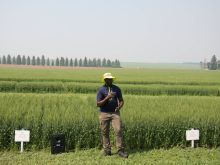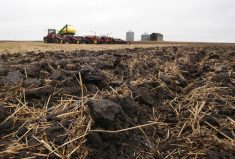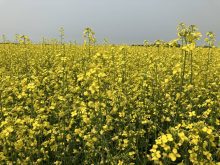Ask a room full of agronomists what’s significant about the year 1993 and the word “fusarium” ripples through the crowd.
It was a memorable year. Much of the wheat in Manitoba, particularly in the Red River Valley, was contaminated with fusarium head blight disease, which affects yields but also creates toxins that can affect human and animal health. The disease is now endemic on the Prairies, although much more is known about how to control its effects through fungicides, cultural practices and screening.
Another significant year is 2003, which will be remembered as the year clubroot first surfaced in an Alberta county. In 2012, it was found for the first time in Saskatchewan.
Read Also

Manitoba boosts stake in cereals centre to $23.5 million
Premier Wab Kinew said the additional project funds will help ‘Trump-proof’ the provincial economy.
Blackleg became endemic to the canola-growing regions of the Prairies in the mid-1970s, forcing a quick search for varieties that offered genetic resistance.
And 1988 was when the industry first acknowledged herbicide-resistant weeds were a reality, that has only worsened with time.
Extension agronomists are already asking whether 2013 will be the year marking the official arrival of soybean cyst nematode in Manitoba.
These dates of dubious distinction in the Prairies’ agronomic history now number in the dozens. But they are all linked by a common thread.
“Weeds and disease are Mother Nature’s way of adding diversity to a system that lacks it,” says Dwayne Beck, manager of the Dakota Lakes Research Farm affiliated with South Dakota State University and a leading proponent of no-till farming.
Beck was in Winnipeg recently to discuss the role crop rotation plays in managing agricultural ecosystems at the Manitoba Agronomists Conference. He offers an alternative view, but it’s one that’s working on a commercial-scale farm.
He stresses farmers need to better manage both the sequence and interval of their rotations if they want to build a resilient cropping system that doesn’t require the heavy use of pest control products.
“Remember those two words, sequence and interval,” he told his audience. “The goal is to be inconsistent.”
Beck isn’t a fan of organic agriculture; he likes to keep his options open. That said, he’s consciously backing away from what he calls the escalating “arm’s race” between farmers and pests.
“We have not used a grass control herbicide in wheat since the 1980s and we do not have wild oats and cheat grass and goat grass that my neighbours have,” he says.
If you think about it, nature is balanced by inconsistency. Spring never comes on exactly the same day every year; when that first frost will hit is anybody’s guess.
Humans, on the other hand, prefer routine. Farmers’ crop rotations typically rotate between three or four crops in the same sequence, cycle after cycle. It may be diverse but in a predictable way.
It’s only a matter of time before nature figures out human routines and responds.
“If you have a problem weed or disease or something, Mother Nature is an opportunist. If you’ve got a problem you’ve created an opportunity,” he said.
He cited corn rootworm in the U.S. as an example.
“The normal habit of corn rootworm is the beetles feed on the silks; the females drop down and lay their eggs at the base of the corn plant and if you plant corn there the next year, the babies eat the roots,” Beck says.
So, farmers went to a corn-bean rotation. In the western Corn Belt, the rootworm eggs now hatch out every two years. In the eastern Corn Belt, the female flies to the soybean field to lay her eggs.
“The first case is because the interval is only two years; the other case is because the corn always follows the soybeans.”
Beck’s approach to crop sequencing would be considered heresy in some agronomic circles. He frequently grows the same crop back to back for two years. But then he doesn’t come back to that crop for several years.
The so-called “stacked rotation” offers an added benefit of improving soil bacteria needed for inoculating soybeans, but it also gives the farmer more flexibility in keeping disease pressure to a minimum and controlling weed or pest resistance.
“You have a clean system and you come back and go boom, boom and Mother Nature sees what you are up to and then you switch to something else,” he says. “It makes a lot of sense. You knock your disease pressure down to really low levels. Plus, it keeps pest populations diverse and confused because of diversity in sequence and interval.”
The beauty and the beast of it though, is that it’s unique to each farm and it’s constantly changing.
“Whenever I get asked what rotation should I use, I ask, who chose your wife? I can tell you a lot of things that are important, but I can’t choose the rotation for you.”














